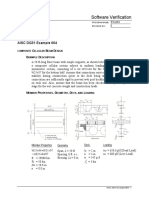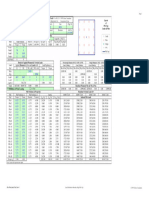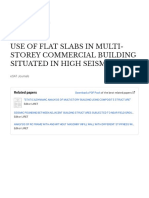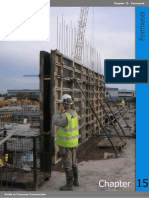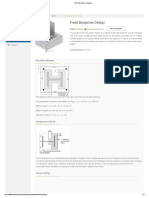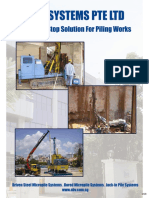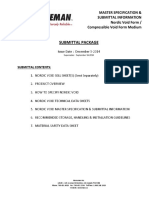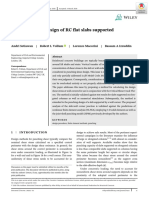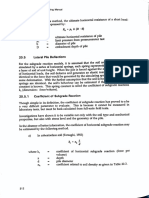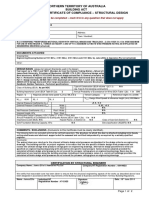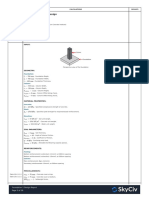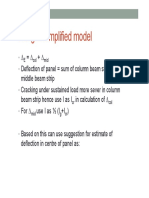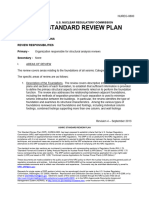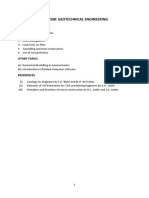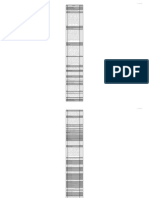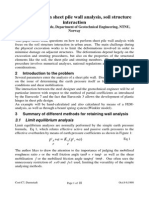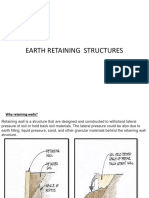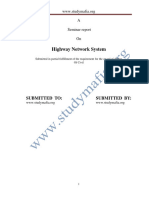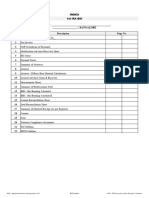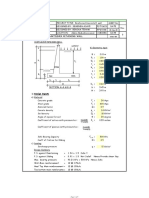PREFACE - DESIGN FEATURES REPORT
The Document that follows is a SESOC preliminary proposal for a Design Features Report
(DFR) to link to the Construction Industry Council Design Documentation Guidelines.
The Design Documentation Guidelines call for a Design Features Report to be completed at
the Preliminary Design Phase, and then updated as the documentation proceeds refer extract
below from the Detailed Design Phase.
Figure 1: Extract from Design Documentation Guide, copyright CIC
The intention of this document is to provide a comprehensive template for structural
engineers to work from for all projects. Its content is deliberately broad, to cover most
structure types and scales. It is recognised that the scope of this document may be broader
than many projects would demand, but we note that it is easier to strike our irrelevant sections
than to add them in later.
This document contains a significant amount of commentary and prompts for users. It is
formatted as hidden text, and can be toggled on and off using the button on your Word
toolbar. The text will appear as green text when toggled on. There is no need to delete this
text when printing, use >Tools>Options>Print to select whether you want the hiddnetext to
print or not.
Althogh substantially ready for use, this document is being published for comment. In
particular we seek input on the following:
1. Overall content do you consider there to be enough information in here to provide a
comprehensive coverage of most structures?
2. Ease of use is the insertion of commentary in the document as hidden text helpful, or
would a separate document be more useful?
A separate short-form document is being prepared for small projects generally applicable to
domestic projects that are substantially in compliance with NZS3604, or other projects of a
similar scale (although it is noted that these are rarely likely to have a CIC Design
Documentation checklist requirement for a DFR).
SESOC DFR draft 1_3.doc
�PROJECT NAME
PROJECT ADDRESS
D E S I G N F E AT U R E S R E P O R T
Report Prepared by:
Reviewed by:
A.N. Engineer
Project Engineer
A.N.Other
Role
SESOC DFR draft 1_3.doc
�Contents
1
GENERAL
1
Objective ............................................................................................................. 1
Scope .................................................................................................................. 1
Means of Compliance ......................................................................................... 1
Alternative Solutions ........................................................................................... 1
THE STRUCTURE
1
General ............................................................................................................... 1
Gravity structure.................................................................................................. 2
Lateral Load Resisting structure ......................................................................... 2
Significant Design Features................................................................................ 2
SOIL CONDITIONS
2
Description of Site Soil Conditions...................................................................... 2
Soil Design Values.............................................................................................. 2
1.1
1.2
1.3
1.4
2
2.1
2.2
2.3
2.4
3
3.1
3.2
3.2.1
Ultimate Soil Strengths.............................................................................. 2
3.2.2
Strength Reduction Factors .................................................................... 2
DESIGN LOADS
2
General ............................................................................................................... 2
Imposed Loads ................................................................................................... 2
4.2.1
Vertical loads ............................................................................................ 2
4.2.2
Barriers and Handrails .............................................................................. 3
4.2.3
Retaining Values....................................................................................... 3
Wind Loads ......................................................................................................... 3
4.3.1
Site Wind Speed Profile............................................................................ 4
4.3.2
Parts of Structure....................................................................................... 4
4.3.3
Glazing ....................................................................................................... 5
4.3.4
Steel Stud Wall Framing. .......................................................................... 5
Snow and Ice Loads ........................................................................................... 5
Seismic Loads..................................................................................................... 5
4.5.1
Site Parameters......................................................................................... 5
4.5.2
Analysis Methodology ............................................................................. 5
4.5.3
Seismic Load Coefficient ........................................................................ 5
4.5.4
Parts and Portions ..................................................................................... 6
Construction Loads ............................................................................................. 6
Special Load Cases ............................................................................................ 6
SERVICEABILITY CRITERIA
6
Seismic Deflections............................................................................................. 6
Wind Deflections ................................................................................................. 6
Gravity Deflections.............................................................................................. 6
Shrinkage and Creep Constants......................................................................... 6
Design Life for Durability..................................................................................... 7
5.5.1
Design Life.................................................................................................. 7
5.5.2
Durability Provisions .................................................................................. 7
5.5.3
Summary of Surface Treatments............................................................ 7
5.5.4
Maintenance Requirements of Surface Treatments .......................... 8
4
4.1
4.2
4.3
4.4
4.5
4.6
4.7
5
5.1
5.2
5.3
5.4
5.5
SESOC DFR draft 1_3.doc
Project Name:
Project No:
�5.6
5.7
Floor Vibration..................................................................................................... 8
Fire Resistance Ratings...................................................................................... 9
SOFTWARE
9
DRAWING AND SPECIFICATION NOTES
9
Floors .................................................................................................................. 9
6
7
7.1
7.1.1
Design Loads ............................................................................................. 9
7.1.2
Fire rating Requirements.......................................................................... 9
7.1.3
Propping Requirements........................................................................... 9
Foundations ...................................................................................................... 10
Material Properties (Typical)............................................................................. 10
7.3.1
Concrete Strengths ................................................................................10
7.3.2
Reinforcing Steel.....................................................................................10
7.3.3
Concrete Masonry .................................................................................11
7.3.4
Structural Steel ........................................................................................11
7.3.5
Structural Timber .....................................................................................11
Proprietary Systems
11
Manufacturer Design Requirements ................................................................. 12
Manufacturer construction requirements .......................................................... 12
Construction Monitoring
12
Soil Testing and verification .............................................................................. 12
Materials Testing............................................................................................... 12
Temporary support and shoring........................................................................ 12
Other ??? ....................................................................................................... 12
Inspection Requirements .................................................................................. 12
7.2
7.3
8
8.1
8.2
9
9.1
9.2
9.3
9.4
9.5
SESOC DFR draft 1_3.doc
ii
Project Name:
Project No:
�1 GENERAL
1.1
Objective
The Design Features Report (DFR) is a detailed document defining the structures design
criteria and recording key decisions or outcomes. It outlines design loading, structural
modelling assumptions, material properties, foundation requirements and design standards.
The DFR also defines the calculation procedure and checking principles to be followed,
providing a clear explanation of the full design.
1.2
Scope
The scope is in accordance with the Design Brief and Conditions of Engagement.
In general terms, the scope of work is as follows:
1.3
Means of Compliance
The design of the structure is in compliance with the New Zealand Building Code (NZBC),
section B1.
The following standards have been used:
AS/NZS1170:2001
NZS3101:1995
NZS3404:1997
1.4
Alternative Solutions
The following alternative solutions have been adopted in the design of the structure:
1. NZS3101:2006 has been used in consideration of.
2 THE STRUCTURE
2.1
General
The structure is..
The location of the structure is
The design life of the structure is 50 years.
SESOC DFR draft 1_3.doc
Project Name:
Project No:
�2.2
Gravity structure
The roof is..
2.3
Lateral Load Resisting structure
The roof and floor diaphragms span horizontally to distribute load to
2.4
Significant Design Features
3 SOIL CONDITIONS
3.1
Description of Site Soil Conditions
Refer to the Soils report - file ?????????.
##Soil conditions are generally uniform over the structure footprint with gravelly silts and
sands overlying gravels. The water table is typically at a depth of 2.5m. For the purposes of
this work, a depth of 2.0m has been assumed. Typically this will only affect the lift pits. ##
3.2
Soil Design Values
3.2.1 Ultimate Soil Strengths
3.2.2 Strength Reduction Factors
Ultimate limit state strength reduction factors:
= 0.5
= 0.8 (seismic)
4 DESIGN LOADS
4.1
General
For the purposes of consideration of loading, this structure Importance Level 1/2/3/4/5 in
accordance with AS/NZS 1170.0:2002.
4.2
Imposed Loads
4.2.1 Vertical loads
SESOC DFR draft 1_3.doc
Project Name:
Project No:
�The table below summarizes all vertical loads including both superimposed dead and
live loads.
In all cases, a minimum superimposed dead load of 0.5 kPa is applied.
Table 1: Imposed Gravity loads
Use
Live Load
Level/Area
Superimposed
Dead Load
Ground Floor
Roof
Plant/Store Rooms
Storage
5.0 kPa
0.5 kPa
4.2.2 Barriers and Handrails
The following loads apply for all barriers and handrails.
Level/area
Table 2: Barrier and Handrail loads
Top Edge
Horizontal
Vertical
kN/m
kN/m
Inwards,
outwards, or
downwards
kN
Infill
Horizontal
Any
direction
kPa
kN
4.2.3 Retaining Values
Soil retaining loads are generally in accordance with the recommendations of the Soils
report. For the design of all retaining walls, the following parameters shall be used:
s = ?? kN/m3
Ka =
Ko =
Kp =
The water table shall be assumed to be at ??? for the design of retaining walls.
Specific seismic design for the retaining walls is/ is not required, because...
4.3
Wind Loads
In accordance with AS/NZS 1170.2:2002.
SESOC DFR draft 1_3.doc
Project Name:
Project No:
�The natural frequency of the structure is ??Hz, therefore the structure is/is not wind sensitive.
A static analysis procedure is applicable.
4.3.1 Site Wind Speed Profile
Region:
A6/A7/W & shadow zone/outer zone
VR:
???
m/s
1.0
N
NE
E
SE
S
SW
W
NW
Any
Md, wind direction multiplier:
Terrain category
1/2/3/4 SLS/ULS
Height, z:
Mz,cat, terrain multiplier:
Ms, shielding multiplier:
Mt, topographic multiplier:
Table 3: Directional Site Wind Speeds
Direction
SLS
Vsit,, for site direction:
m/s
ULS
m/s
1
2
3
4
4.3.2 Parts of Structure
Pressure coefficients are used in accordance with ?? to give design wind pressures.
Typical wind pressure coefficients used are:
Table 4: Wind Pressure Coefficients
max
min
0.6
Internal, Cp,i
SESOC DFR draft 1_3.doc
-0.3
Project Name:
Project No:
�Wall Cp,e, windward
Wall Cp,e, leeward
Wall Cp,e, side
Roof Cp,e, upwind
Roof Cp,e, downwind
Roof Cp,e, crosswind
Canopies
4.3.3 Glazing
Wind loads for glazing to be in accordance with the NZ Building Code and NZS
4223:1985, Code of practice for glazing in buildings.
4.3.4 Steel Stud Wall Framing.
4.4
Snow and Ice Loads
The structure is in Region N1/2/3/4/5, and the elevation is ???m above sea level. Snow and
ice are/are not significant loads for this structure.
4.5
Seismic Loads
4.5.1 Site Parameters
Site subsoil class:
Proximity to fault:
A/B/C/D/E
>100km.
4.5.2 Analysis Methodology
The seismic analysis has been completed in accordance with AS/NZS 1170.5:2002,
using the equivalent static/modal response spectrum/time history analysis method.
Design Spectra are in accordance with AS/NZS 1170.5:2002 for site subsoil class
A/B/C/D/E.
For the purposes of the analysis, the project x and y directions are considered to be the
project north and east directions respectively.
4.5.3 Seismic Load Coefficient
In accordance with AS/NZS 1170.5:2002 section ?.
SESOC DFR draft 1_3.doc
Project Name:
Project No:
�Zone factor,
Period,
Z
Tx
Ty
Ch
4.5.4 Parts and Portions
In accordance with AS/NZS1170.5:2002 section 8.
Refer to calculations.
4.6
Construction Loads
4.7
Special Load Cases
To be reviewed as work proceeds - typically will be as a result of construction requirements.
5 SERVICEABILITY CRITERIA
5.1
Seismic Deflections
Refer to calculations - File 2930-040.
Type of Analysis :
Static/Response Spectrum/Time History
Maximum Allowable :
ULS 0.02h for hn<=15m (generally the case)
0.02h - 0.005(hn-15)/15 for 15m <hn<30m
in accordance with Table C2.4.1 NZS 4203:1992
SLS
5.2
Wind Deflections
Particular elements are designed to the recommended serviceability deflection limits of
AS/NZS 1170.0:2002, Table C1.
5.3
Gravity Deflections
Particular elements are designed to the recommended serviceability deflection limits of
AS/NZS 1170.0:2002, Table C1.
5.4
Shrinkage and Creep Constants
SESOC DFR draft 1_3.doc
Project Name:
Project No:
�The effects of shrinkage and creep in beams and slabs have been accounted for by multiplying
the dead and sustained live load deflections by the factor Kp.
Where Kp =
2 - 1.2*A's/As
The effect of creep and shrinkage in columns is considered negligible due to the low height of
the structure.
5.5
Design Life for Durability
5.5.1 Design Life
Foundations :
50 yrs
Superstructure:
50 yrs
Note: non structural elements and cladding specification are by [architects name? /
others] and are not covered by this design features report.
5.5.2 Durability Provisions
Durability provisions are achieved by:
Acceptable Solutions B2/AS1
Reinforced Concrete: NZS 3101: 1995 Part 1 Section 5 is an acceptable solution
for durability with durability requirements met through covers equal to or in
excess of the requirements of the standard.
Timber: NZS 3602: 2003 Part 1 is an acceptable solution for meeting durability
through treatment in accordance with the standard.
Light Timber Framing Structures: NZS 3604:1999 is an acceptable soloution for
meeting durability requirements of buildings within its scope and includes
framimg and metal fixings.
Alternative Solutions
Structural Steel: There is no acceptable solution available for structural steel and
protection is provided through surface treatment in accordance with NZS/AS
2312:2002.
5.5.3 Summary of Surface Treatments
SESOC DFR draft 1_3.doc
Project Name:
Project No:
�The table below summarises the surface treatments for the structural elements covered
by this design features report.
Element
Table 5: Schedule of Surface Treatments
Design Exposure Surface Treatment in
Life
Category accordance with NZS/AS 2312
Time to first
major
maintenance
Exposed exterior
Structural
Steelwork to
structure - Portal
Rafters
Canopy structures
unpainted and
painted
50
Medium
Metal Spray Zinc 150 microns
NZS 2312 - TZ150
25+
50
Medium
25+
Interior Structural
Steelwork
50
Low
Hot Dipped Galvanised (after
fabrication) 85 microns
NZS 2312 - HDG600
Alternative + decorative paint*
system HDG + 80 microns
NZS2312 - HDG600P2
(*paint system by architect)
Painted Zinc Primer with 2
coats Acrylic Latex.
15-25
5.5.4 Maintenance Requirements of Surface Treatments
The maintenance requirements for the above protective coating systems in 5.5.3 are as
per NZS/AS 2312.
From section 10.2 of the standard the criteria for assessing when to paint or repair the
coating systems are:
[INSERT SECTION 10.2 FROM THE STANDARD NZS 2312 INTO DFR] (to make
the maintenance requirements treatments clear to the T/A, Reviewer, and Client)
5.6
Floor Vibration
The floors have been checked using the criteria proposed in the BRANZ report SR 14 (1988)
"Serviceability Criteria for Buildings".
Transient vibration limits for composite structural steel floors/beams to be checked using a
method proposed by Murray which determines the amount of damping required for acceptable
behaviour.
Transient vibration limits for the precast seating units to be not less than 5 hz.
Continuous vibration limits have been checked using a method proposed by Allen which
identifies floor systems which are likely to resonate when subjected to cyclic excitation.
It was found that the floor system proposed falls within acceptable limits on both counts.
SESOC DFR draft 1_3.doc
Project Name:
Project No:
�5.7
Fire Resistance Ratings
Typically, fire plan requires 30 min structural rating. Compliance is to be achieved via:
Concrete
- covers in accordance with NZS 3101:1995
Steel
- boarded or painted passive treatment or verified by
specific design.
6 SOFTWARE
The following computer applications were used for the design:
Analysis type
Seismic response spectra
analysis
2D frame analysis
General spreadsheet
design
Etc
Table 6: Software used in design
Software used
Archive files
Name them
List current/final design
spreadsheets individually
7 DRAWING AND SPECIFICATION NOTES
The purpose of this section is to ensure that the design requirements are included in the
drawings or the specification.
7.1
Floors
7.1.1 Design Loads
Refer to Section 2 DESIGN LOADS, section 5.3 Gravity Deflections and Section 5.6
Floor Vibration.
7.1.2 Fire rating Requirements
Refer to Section 5.7 Fire Resistance Ratings
7.1.3 Propping Requirements
Generally, the propping of composite metal deck slab shall be in accordance with the
manufacturers recommendations.
The propping of precast shell beams and hollowcore flooring units shall be in strict
accordance with the manufacturers requirements and shop drawings.
SESOC DFR draft 1_3.doc
Project Name:
Project No:
�The temporary propping and handling of all other precast and insitu concrete and
structural steel capacity including roof trusses shall be in accordance with the
specification. Generally, this will be the Contractors responsibility to ensure
compliance with the Building Code and all health and safety regulations.
7.2
Foundations
Refer to the Excavation and Concrete - General sections of the specification which discuss in
detail all requirements for the foundations.
7.3
Material Properties (Typical)
7.3.1 Concrete Strengths
Foundations:
?? MPa
Arena Ground Floor:
?? MPa
Lift pit walls, base slab
?? MPa
Columns - Insitu:
?? MPa
Beams - Insitu:
?? MPa
Precast columns, beams,frames:
?? MPa
Slabs - Insitu:
?? MPa
Slabs - Precast :
?? MPa
Floor toppings:
?? MPa
Precast balcony units
?? MPa
7.3.2 Reinforcing Steel
Column Longitudinal Rein:
??? MPa
Beam Longitudinal Rein:
??? MPa
Slab Rein:
??? MPa
Column Ties:
??? MPa
Beam Stirrups:
??? MPa
SESOC DFR draft 1_3.doc
10
Project Name:
Project No:
�Blockwall Rein:
??? MPa
7.3.3 Concrete Masonry
Blockwalls:
Grade B
7.3.4 Structural Steel
Rolled Steel Sections:
300MPa Grade 300 L0 to AS 3679.1 ???
Steel Plate General
250 MPa Grade HA250 to AS1594??
Steel Plate (special)
300 MPa Grade 300 MOD ????
StelTech Beams
etc
CHS Hollow Sections
eg
RHS Hollow Sections:
AS 1163 - 350MPa grade
Bolt Grades:
Grade 4.6 mild steel and grade 8.8 high strength
Tensioning requirements for 8.8 bolts
7.3.5 Structural Timber
To come HJH?
8 PROPRIETARY SYSTEMS
The following proprietary elements are included in the project:
Timber Trusses Pryda etc
Timber Floors and roofs - Posistrut / Beams/ Hyspan / Hy joist / LVL
Timber conectors Pryda / Lumberlok
Bracing systems GIB, Hardies, Ecoply
Cold formed DHS purlins / rafters - Dimond, HST, Formsteel
Cold formed Studs Steel Tray Composite flooring Hibond / Traydeck / Comflor
Precast proprietary flooring
Precast shell beams
SESOC DFR draft 1_3.doc
11
Project Name:
Project No:
�8.1
Manufacturer Design Requirements
Include notes here as to the design assumptions and criteria that the proprietary systems must
meet. Include description of:
8.2
Loads
Durability
Design Submissions required design for review, shop drawings,
PS1 and 2(if required)
Manufacturer construction requirements
Inspection QA requirements
Producer Statement PS3/4 by manufacturer or any testing results.
??????
9 CONSTRUCTION MONITORING
The design is based on the verification of specific design aspects of the construction by a
suitably qualified Chartered Professional Engineer in accordance with ACENZ/IPENZ level
CM 1/2/3/4.
These include the following assumptions:
9.1
Soil Testing and verification
Visual inspection of excavation as work proceeds. This may include the removal and filling
of softspots with compacted hardfill as required by the Specification.
9.2
Materials Testing
9.3
Temporary support and shoring
9.4
Inspection Requirements
SESOC DFR draft 1_3.doc
12
Project Name:
Project No:
�The following schedule of inspections is to be met in order to meet the required level of
Construction Monitoring, and to ensure the intent of the design is met:
Inspection
Pre start
Services
Relocation
Demolition
Earthworks
Bulk
Earthworks
Trimming to
level
Backfilling
Piling
Drilling
Table 7: Schedule of Inspections
Reason
Stage
S= Start
M= Monitor
ongoing
progress
C= completion
S
Contract start,
specification, programme
and methodology
S, M, C
Engineer attends
S, M
S, C
S, M, C
Engineer attends
Procedure audit
Inspect materials verify
ground conditions
Inspect materials
X
X
X
X
X
X
Inspect materials
Procedure audit
Verification of drilling
ground conditions
Pour approval
S, M, C
S, M, C
S
S, M, C
S, M, C
Person
T/A SHL
Geotec
h
X
X
X
X
X
X
X
X
Reinforcing
steel
Concreting
S, M, C
Inspect concrete
placement
Soil nails
Drilling
S, M, C
Installation
S, M, C
Proof test
M, C
Verification of drilling
ground conditions
Inspect installation and
grouting
Select anchors to be
proof tested and test
Sprayed
concrete
Spraying
S, C
Equipment, procedure,
finish
Method
Curing
Abutments
Excavation
S, C
Backfilling
Reinforcing
Formwork
Concrete
S, M, C
S, M, C
C
S, M, C
SESOC DFR draft 1_3.doc
S, C
Verification of ground
conditions
Inspect materials
Pour approval
Pour approval
Monitor procedure,
13
X
X
X
X
X
X
Project Name:
Project No:
�Inspection
Placement
Curing
Stage
Approaches
Bearings
Steel beams
Fabrication
Protection
S
S
S, M, C
S, M, C
Delivery
S, C
Placement /
Erection
Concrete deck
Soffit
formwork
Reinforcing
and Formwork
Pour
S, M, C
Curing
S, C
Basecourse
S, M, C
Drainage
Paving
Kerb and
channel
Handrail
S, M, C
S, M, C
S, C
Road marking
S, C
SESOC DFR draft 1_3.doc
S, C
S, C
S, M, C
S, M, C
S, C
Reason
inspect quality and finish
Monitor procedure,
inspect quality and finish
Backfill approval
Specification check
Person
X
X
X
Welding
Coating thickness and
procedure
Protection system,
dimensions
Procedure, integrity,
bolting etc
X
X
Check of integrity of
system
Pour approval
Monitor procedure,
inspect quality and finish
Monitor procedure,
inspect quality and finish
Strength, materials,
placement techniques
Materials, placement
Surface
Alignment
Position, specification,
finish
Position
14
X
X
X
X
X
X
X
X
X
X
X
Project Name:
Project No:
